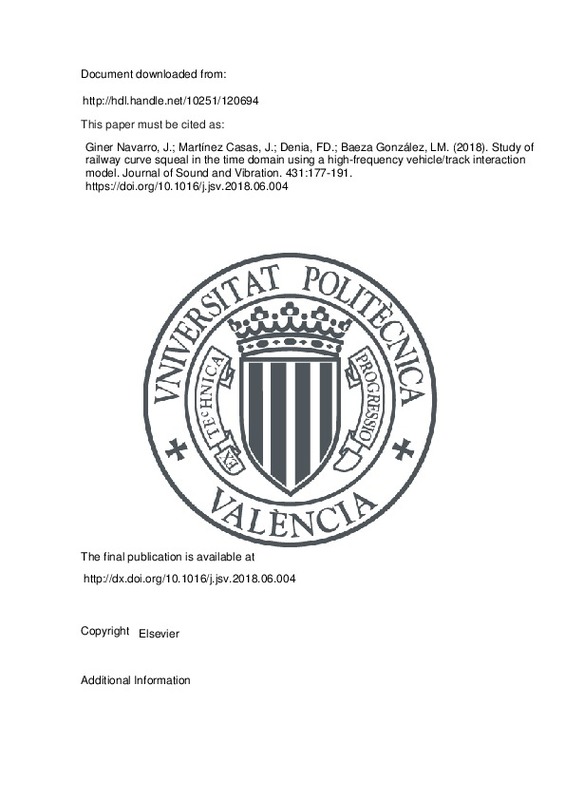JavaScript is disabled for your browser. Some features of this site may not work without it.
Buscar en RiuNet
Listar
Mi cuenta
Estadísticas
Ayuda RiuNet
Admin. UPV
Study of railway curve squeal in the time domain using a high-frequency vehicle/track interaction model
Mostrar el registro sencillo del ítem
Ficheros en el ítem
| dc.contributor.author | Giner Navarro, Juan
|
es_ES |
| dc.contributor.author | Martínez Casas, José
|
es_ES |
| dc.contributor.author | Denia, F. D.
|
es_ES |
| dc.contributor.author | Baeza González, Luis Miguel
|
es_ES |
| dc.date.accessioned | 2019-05-19T20:01:25Z | |
| dc.date.available | 2019-05-19T20:01:25Z | |
| dc.date.issued | 2018 | es_ES |
| dc.identifier.issn | 0022-460X | es_ES |
| dc.identifier.uri | http://hdl.handle.net/10251/120694 | |
| dc.description.abstract | [EN] Railway curve squeal is an intense tonal and annoying type of noise commonly attributed to self-excited vibrations during curving. The mechanisms for its generation remain unclear and it is still a subject of discussion among researchers. Most of them have considered the falling behaviour of the friction coefficient with the slip velocity essential for reenergising the system. Recently, some authors have found that squeal can also appear even for constant friction coefficient through the wheel modal coupling between the normal and tangential directions caused by the wheel/rail contact. This paper particularly evaluates whether the latter mechanism is sufficient to find squeal in curving conditions. The introduction of flexibility in the railway subsystems is required to widen the domain to the high-frequency range in which squeal occurs. One single flexible and rotatory wheelset is considered and suitable forces are prescribed at the primary suspension seats in the current investigation. The rails are modelled through the Moving Element Method (MEM), permitting to extend the range of validity of beam models usually utilised in the literature. This work extends the formulation to rails supported by a viscoelastic Winkler bedding. Both wheelset and track models are coupled by means of a non-linear and unsteady wheel/rail contact model based on Kalker¿s Variational Theory. Simulation results for different track curvatures and friction coefficients are presented and discussed, showing tonal peaks in the tangential contact forces of the inner wheel. These results can be associated with squeal according to the characterisation of this phenomenon, indicating that squeal can be found in curving conditions using advanced dynamic interaction models even with constant friction coefficient. | es_ES |
| dc.description.sponsorship | The authors gratefully acknowledge the financial support of Spanish Ministry of Economy, Industry and Competitiveness and the European Regional Development Fund (project TRA2017-84701-R), as well as Generalitat Valenciana (project Prometeo/2016/007) and European Commission through the project "RUN2Rail - Innovative RUNning gear soluTiOns for new dependable, sustainable, intelligent and comfortable RAIL vehicles" (Horizon 2020 Shift2Rail JU call 2017, grant number 777564). | es_ES |
| dc.language | Inglés | es_ES |
| dc.publisher | Elsevier | es_ES |
| dc.relation.ispartof | Journal of Sound and Vibration | es_ES |
| dc.rights | Reconocimiento - No comercial - Sin obra derivada (by-nc-nd) | es_ES |
| dc.subject | Curve squeal | es_ES |
| dc.subject | Wheel/rail contact | es_ES |
| dc.subject | Rotating wheelset | es_ES |
| dc.subject | Moving Element Method | es_ES |
| dc.subject | Railway high-frequency dynamics | es_ES |
| dc.subject.classification | INGENIERIA MECANICA | es_ES |
| dc.title | Study of railway curve squeal in the time domain using a high-frequency vehicle/track interaction model | es_ES |
| dc.type | Artículo | es_ES |
| dc.identifier.doi | 10.1016/j.jsv.2018.06.004 | es_ES |
| dc.relation.projectID | info:eu-repo/grantAgreement/EC/H2020/777564/EU/Innovative RUNning gear soluTiOns for new dependable, sustainable, intelligent and comfortable RAIL vehicles/ | es_ES |
| dc.relation.projectID | info:eu-repo/grantAgreement/AEI/Plan Estatal de Investigación Científica y Técnica y de Innovación 2013-2016/TRA2017-84701-R/ES/DESARROLLO DE UN MODELO INTEGRAL DE INTERACCION VEHICULO%2FVIA EN CURVA PARA LA REDUCCION DEL IMPACTO ACUSTICO DEL TRANSPORTE FERROVIARIO/ | es_ES |
| dc.relation.projectID | info:eu-repo/grantAgreement/Shift2Rail Joint Undertaking//777564/ | es_ES |
| dc.relation.projectID | info:eu-repo/grantAgreement/GVA//PROMETEO%2F2016%2F007/ES/Modelado numérico avanzado en ingeniería mecánica/ | es_ES |
| dc.rights.accessRights | Abierto | es_ES |
| dc.contributor.affiliation | Universitat Politècnica de València. Departamento de Ingeniería Mecánica y de Materiales - Departament d'Enginyeria Mecànica i de Materials | es_ES |
| dc.description.bibliographicCitation | Giner Navarro, J.; Martínez Casas, J.; Denia, FD.; Baeza González, LM. (2018). Study of railway curve squeal in the time domain using a high-frequency vehicle/track interaction model. Journal of Sound and Vibration. 431:177-191. https://doi.org/10.1016/j.jsv.2018.06.004 | es_ES |
| dc.description.accrualMethod | S | es_ES |
| dc.relation.publisherversion | http://dx.doi.org/10.1016/j.jsv.2018.06.004 | es_ES |
| dc.description.upvformatpinicio | 177 | es_ES |
| dc.description.upvformatpfin | 191 | es_ES |
| dc.type.version | info:eu-repo/semantics/publishedVersion | es_ES |
| dc.description.volume | 431 | es_ES |
| dc.relation.pasarela | S\363255 | es_ES |
| dc.contributor.funder | Generalitat Valenciana | es_ES |
| dc.contributor.funder | Shift2Rail Joint Undertaking | es_ES |
| dc.contributor.funder | Agencia Estatal de Investigación | es_ES |







![[Cerrado]](/themes/UPV/images/candado.png)

